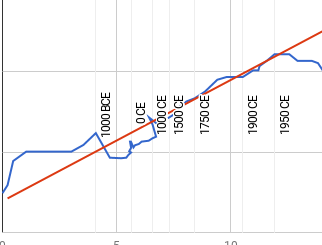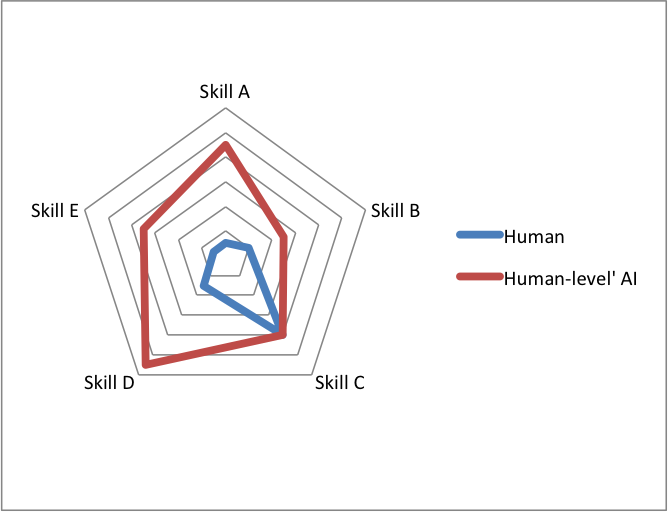In April 2015, the lowest GFLOPS prices we could find were approximately $3/GFLOPS. However recent records of hardware performance from 2015 and earlier imply substantially lower prices, suggesting that something confusing has happened with these sources of data. We have not resolved this.
Recent data
We have not finished exploring the apparent discrepancies between 2015 prices for performance and current records of 2015 prices for performance. However in the data described in our 2017 assessment of recent price trends (key figure here), prices appear to have been below $1 since 2008.1 The measurements are not entirely comparable, but we would not expect the differences to produce such a large price difference.
2015 research
The rest of this page is largely taken from our page written in 2015.
In April 2015, the lowest recorded GFLOPS prices we knew of were approximately $3/GFLOPS, for various CPU and GPU combinations. Amortized over three years, this was $1.1E-13/FLOPShour. Prices in the $3-5/GFLOPS range seemed to be common, for GPU and CPU combinations and sometimes for supercomputers. Using CPUs, prices were at least $11/GFLOPS, and computing as a service cost more like $160/GFLOPS.
Background
We have written about long term trends in the costs of computing hardware. We were interested in evaluating the current prices more thoroughly, both to validate the long term trend data, and because current hardware prices are particularly important to know about.
Details
We separately investigated CPUs, GPUs, computing as a service, and supercomputers. In all categories, we collected some contemporary instances which we judged heuristically as especially likely to be cost-effective. We did not find any definitive source on the most cost-effective in any category, or in general, so our examples are probably not the very cheapest. Nevertheless, these figures give a crude sense for the cost of computation in the contemporary market. Our full dataset of CPUs, GPUs and supercomputers is here, and contains data on twenty two machines. Our data on computing as a service is all included in this page.
Included costs
For CPUs and GPUs, we list the price of the CPU and/or GPU (GPUs were always used with a CPU, so we include the cost for both), but not other computer components. We compared prices between one complete rack server and the set of four processors inside it, and found the complete server was around 36% more expensive ($30,000 vs. $22,000). We expect this is representative at this scale, but diminishes with scale.
For computing services, we list the cheapest price for renting the instance for a long period, with no additional features. We do not include spot prices.
For supercomputers, we list costs cited, which don’t tend to come with elaboration. We expect that they only include upfront costs, and that most of the costs are for hardware.
We have not included the costs of energy or other ongoing expenses in any prices. Non-energy costs are hard to find, and we suspect a relatively small and consistent fraction of costs. Energy costs appear to be around 10% of hardware costs. For instance, the Intel Xeon E5-2699 uses 527.8 watts and costs $5,190.2 Over three years, with $0.05/kWh this is $694, or 13% of the hardware cost. Titan also uses 13% of its hardware costs in energy over three years.3 We might add these costs later for a more precise estimate.
FLOPS measurements
To our knowledge we report only empirical performance figures from benchmark tests, rather than theoretical maximums. We sometimes use figures for LINPACK and sometimes for DGEMM benchmarks, depending on which are available. Geekbench in particular does not use the common LINPACK, but LINPACK relies heavily on DGEMM, suggesting DGEMM is fairly comparable. We guess they differ by around 10%.4
Prices
Central processing units (CPUs)
We found prices and performance data for five contemporary CPUs, including three different instances of one of them. They ranged from $11-354/GFLOPS with most prices below $100/GFLOPS.5 The cheapest of these CPUs still looks several times more expensive than some GPUs and supercomputers, so we did not investigate these numbers in great depth, or search far for cheaper CPUs.
Graphics processing units (GPUs)
We found performance data for six recent combinations of CPUs and GPUs (with much overlap between CPUs and GPUs between combinations. They ranged from $3.22/GFLOPS to $4.17/GFLOPS.
Note that graphics cards are typically significantly restricted in the kinds of applications they can run efficiently; this performance is achieved for highly regular computations that can be carried out in parallel throughout a GPU (of the sort that are required for rendering scenes, but which have also proved useful in scientific computing).
Computing as service
Another way to purchase FLOPS is via virtual computers.
Amazon Elastic Cloud Compute (EC2) is a major seller of virtual computing. Based on their current pricing, renting a c4.8xlarge instance costs about $1.17 / hour.6 This is their largest instance optimized for computing performance (rather than e.g. memory). A c4.8xlarge instance delivers around 97.5 GFLOPS.7 This implies that a GFLOPShour costs $0.012. If we suppose this is an alternative to buying computer hardware, then the relevant time horizon is about three years. Over three years, renting this hardware will cost $316/GFLOPS, i.e. around two orders of magnitude more than buying GFLOPS in the form of GPUs.
Other sources of virtual computing seem to be similarly priced. An informal comparison of computing providers suggests that on a set of “real-world java benchmarks” three providers are quite closely comparable, with all between just above Amazon’s price and just under half Amazon’s price for completing the benchmarks, across different instance sizes. This analysis also suggests Amazon is a relatively costly provider, and suggests a cheap price for virtual computing is closer to $0.006/GFLOPShour or $160/GFLOPS over three years.
Even with this optimistic estimate, virtual computing appears to cost something like fifty times more than GPUs. This high price is presumably partly because there are non-hardware costs which we have not accounted for in the prices of buying hardware, but are naturally included in the cost of renting it. However it is unlikely that these additional costs make up a factor of fifty.
Supercomputing
The Titan supercomputer purportedly cost about $97M to produce, or about $4,000 dollars per hour amortized over 3 years. It performs 17,590,000 GFLOPS which comes to $5.51/GFLOPS. This makes it around the same price as the cheapest GPUs. It is made of a combination of GPUs and CPUs, so this similarity is unsurprising.
The other six built supercomputers we looked at were more expensive, ranging up to $95/GFLOPS. Another cost-effective supercomputer, the L-CSC, was being built at the time it was most recently reported on, and while it should be completed now we could not find more data on it. Extrapolating from the figures before it was finished, when completed it should cost $2.39/GFLOPS, and thus be the cheapest source of FLOPS we are aware of.
Summary
The lowest recorded GFLOPS prices we know of are approximately $3/GFLOPS, for various CPU and GPU combinations. Amortized over three years, this is $1.1E-13/FLOPShour. Prices in the $3-5/GFLOPS range seem to be common, for GPU and CPU combinations and sometimes for supercomputers. Using CPUs, prices are at least $11/GFLOPS, and computing as a service costs more like $160/GFLOPS.
- Other examples of apparently very cheap hardware from 2015 or earlier can be seen at the bottom of the sheet called ‘Oct 2017 Update – misc – incomplete, misleading’ in this spreadsheet.
- The processor can be bought here for $5,190 as of April 1 2015. Its energy consumption is 527.8 watts under load, or 90.9 watts idle.
- Titan cost about $4000 dollars per hour amortized over 3 years, and consumes about 10M watts, at a cost of $500 per hour (assuming $0.05 per kWh), which is also 13% of its hardware cost.
- This presentation (page ‘Results on a single node’) reports Linpack performance of 95% and 89% of DGEMM performance for their hardware in two tests.
- Muehlhauser and Rieber extended Koh and Magee’s data on MIPS available per dollar to 2014 (data available here). Their 2014 datapoint is for Intel Core i5-4430 and is 607 MIPS/$, and is roughly in line with their figures for recent years. According to Geekbench, it achieves 15.7 GFLOPS on the DGEMM benchmark. According to PCworld, it initially cost $175, and we have not found cheaper prices than this. This implies $11.14/GFLOPS. However Muehlhauser and Rieber seem to report a price of $48, which would make it $3.06/GFLOPS, highly competitive with GPUs and supercomputers. They also cite CPUworld, so we suspect this is an error. Either way, this CPU would not be substantially cheaper than the best GPUs, so does not alter our results.
- The effective hourly rate, if you purchase 3 years of computing, and pay upfront, is $1.1653 per hour.
- Geekbench Browser allows users to measure performance in FLOPS using a variety of tasks. 97.5 is the multi-core DGEMM score a user reported for c4.8xlarge. We use a multi-core score because the cost cited is for purchasing all of the cores. On other tasks, Geekbench reports scores from 46 to 199 GFLOPS. We do not know how reliable Geekbench reports are.



Any comment on the recent drop of computational prices? 110 teraflops of computing power,for 3000 USD for NVIDIA Volta
https://www.pcgamesn.com/nvidia-titan-v-volta
means 0.01 USD for gigaflop compared with 3 (or 1) USD for gigaflop in 2015. Anyway, it is 100 times drop in 3 years, which probably jump out of the curve.
Let the big brother of all, Intel come out with whole range. Movidius and Nervana should take the figure to another level, mainly by price and power consumption parameters
I do feel like not including “costs of energy or other ongoing expenses in any prices” might make the data more noisy.
While it might be true that the 10% ballpark for (compute) energy is acceptable [1], if you have a Titan-like supercomputer, or Amazon Web Services (AWS) data center, cooling costs might be non negligible…
Also, taking into account the impact of hardware failure rates in equipment at scale might matter (as well as its evolution over time).
For example, BackBlaze has openly documented annualised failure rates for HDDs over the last few years, and these can vary a lot (between ~1-10% per year).
This goes beyond the computing hardware: to power distribution systems, cooling systems, etc.
Finally, and most difficult to pin down, are the hardware and software maintenance costs. Hiring someone to go and swap that burnt-out CPU or GPU. The development and running costs of software that handles High-Availability and transfers work to another machine when a power unit fails, etc.
If these costs were taken into account, I suspect the AWS profit margins won’t be 50 fold anymore, and Titan won’t be the cheapest GFLOP-per-buck anymore.
If comparing apples and oranges, they will look different.
[1] If we take the Titan supercomputer, it is reported (Top500 list) to consume 8,209 kW, which at your energy prices (0.05 USD / kWh) gives us 11.1%
Helpful post! This really useful. In my experience that these methods work well.
Looking forward to more posts! garden help ������